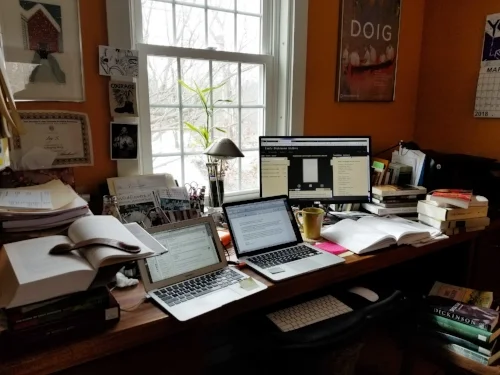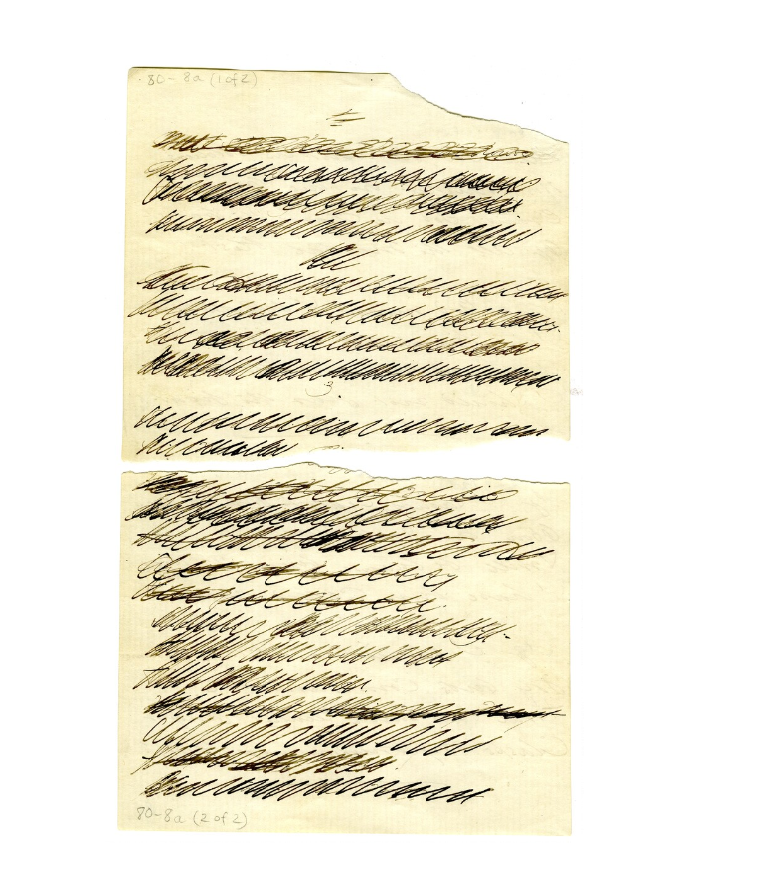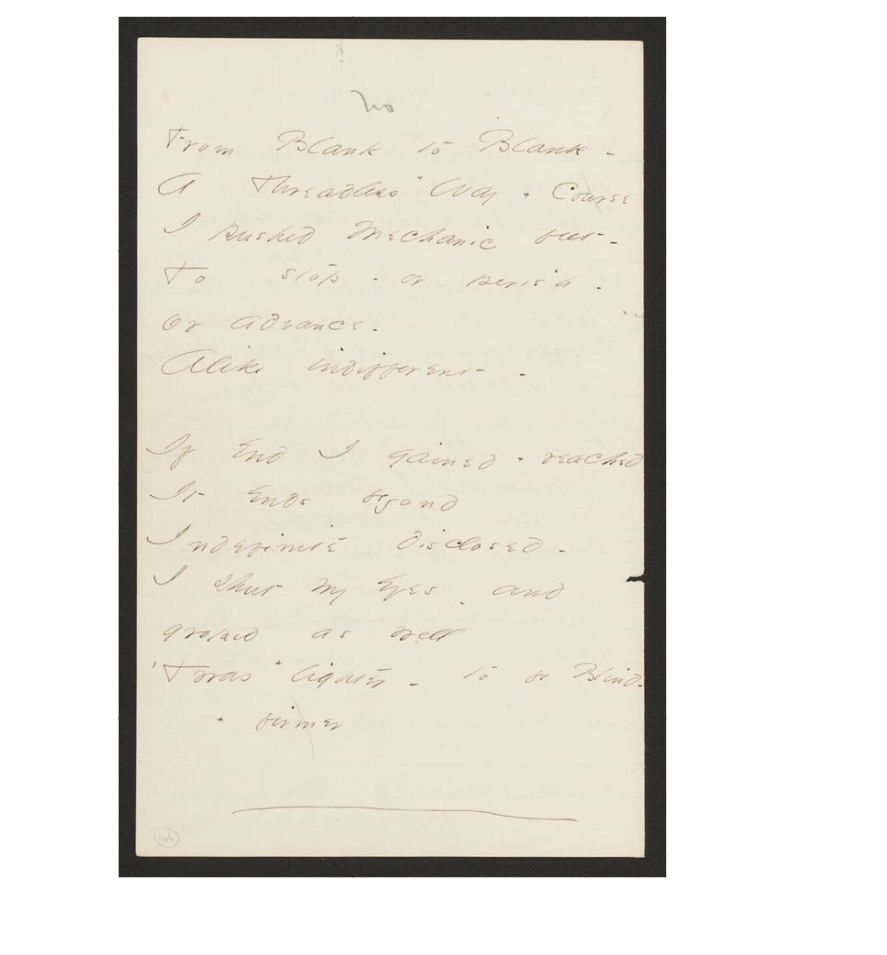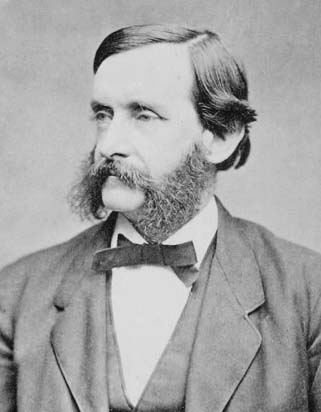It’s a sunny, cool but nearly warm early spring day. Snow piles are still lingering here and there, but flowers are just beginning to pop up outside Ivy Schweitzer's home in Norwich, Vermont. Ivy greets us warmly and gives us a tour of her office with its towering stacks of books about Emily Dickinson and her greenhouse, looking more like summer than spring. Her home is welcoming and warm, her desk is overflowing with books and notes and screens, all devoted to her current obsession: Emily Dickinson.

Ivy is a Professor of English at Dartmouth College and we talk of colleges, English majors, experiential learning, working with incarcerated women, and the "Grace Paleys" of the world who want to change the system.
We first met Ivy a year ago when she had just been to The Morgan Library in NYC to see the exhibit, "I'm Nobody! Who are you? The Life and Times of Emily Dickinson." This morning we are meeting up with Ivy to hear more about her latest project, "White Heat," a blog that chronicles Dickinson's creative life and poetry week by week for the crucial year 1862, and provides cultural and historical contexts to this poet’s notoriously difficult work.
After a tour of her office and greenhouse, Ivy invites us into her kitchen for tea and snacks and we begin to talk...

Shari: What is it about Emily Dickinson that you were so drawn to her?
Ivy: In reality, I’m an early Americanist. I teach American Literature courses about the 17th, 18th, and a little bit of the early 19th centuries. I always teach Dickinson and Whitman and Emerson and all those writers, but I never really focus on them.
And then I did a digital project on Samson Occom, an 18th century Mohegan Indian who was converted to Christianity by the brother-in-law of the founder of Dartmouth College, Eleazer Wheelock. Occom turned out to be a brilliant student and gave Wheelock the idea to create an Indian charity school that eventually became Dartmouth.
In 2007 I started a project at Dartmouth to create a digital scholarly edition of the papers we hold in our special collections by Occom and also about him. It's called “The Occom Circle.” I had so much fun. In researching Occom, I came across the Emily Dickinson Archive, the EDA, which is an archive that Harvard University and the Houghton Library put together along with Amherst College and the other large holders of Dickinson manuscripts to create what is essentially an amazing, useful, and revealing resource.
From there, I then found the DEA, the Dickinson Electronic Archives. This was started by a group of scholars to share their work and collaborate around Dickinson based on the digitization of Dickinson’s manuscripts. When the EDA made available online Dickinson’s manuscripts that Ralph Franklin published in 1981, that changed Dickinson studies forever.
Rebecca: Everything was revealed then.
I: Everything was revealed. It was revealed how Thomas Johnson, who edited the first complete collection (The Poems of Emily Dickinson in 1955) and Franklin (who brought out his Variorum edition in 1998) made editorial choices and didn't actually print what Dickinson had written in the fascicles, the 40 booklets of fair copies she started to put together and hand-sew in 1858—a form of self-editing.
But Franklin’s books are very expensive. Only a certain number of people could see those manuscripts. When they were digitized and put online, everybody could see them and see for themselves what Dickinson wrote. We're still trying to figure that out!
The DEA was set up by scholars who want to work and share digitally. The materials on that site are fantastic. There's a whole section on mutilations. People—we think we know who they are—mutilated some of the Dickinson manuscripts.
R: I saw the poem about Sue, Dickinson’s beloved sister-in-law, that was completely obliterated!

"Once sister have I in our house / And one hedge away"
Credits: Amherst College, Amherst MA
Amherst Manuscript #fascicle 80
Amherst - Amherst Manuscript #fascicle 80 - There is a word - asc:12107 - p. 9
I: The entire poem! You have to be really pissed off to do that. It's not like you just said, "Oh, I don't like this word," or, "Let's get rid of her name." No, no, they scratched out every line, with a vengeance.
R: And whoever it was didn't shred it, didn't throw it away, just carved it up with a pen and left it there.
I: Exactly. Something like that doesn’t get into a “Collected Works.”
Dickinson scholars like Martha Nell Smith and Marta Werner have been using the digital platform to undertake what they call "unediting Dickinson." That is, working from her manuscripts, not from versions created by, largely, male editors, stripping all that away. Editors always want to arrive at an “authoritative” version; they don’t like ambiguity. In fact, Cristanne Miller just brought out an edition of Dickinson that reproduces the fascicles called Emily Dickinson’s Poems: As She Preserved Them. I know my project, “White Heat,” might seem like it's kind of re-editing her, but we're working from the manuscripts and curating her; every transcription of her poems and letters we offer is based on the manuscript version, not on Franklin or Johnson’s version.
S: Why is the version of her poems so important to reading Dickinson?
Because Dickinson was an incredible innovator in style and form. All of the poems published during her life (10 in total) were regularized to fit the conventions of the day. Even after her death, her editors regularized her poems, removing capitalizations and dashes, changing words they thought odd, organizing them into sappy categories like, Life, Love, Nature and Time and Eternity, and giving them reductive titles like “The Chariot” for the mind-boggling poem “Because I could not stop for Death / He kindly stopped for me.”
I remember the first time I taught the course that I developed as preparation for this project, called "The New Dickinson: After the Digital Turn." We were using the hard copy of Franklin’s edition, and I said to the students, "Now I want you to find the poem you're working on in the EDA, look at the manuscript and compare them," and they came in and were so angry! They said, "He didn't put that in! Where's that dash?! He gets that word wrong!" My students were up in arms over how Dickinson had been forced to conform to current publishing conventions.
R: Do you think there’s value in studying the edited versions of Dickinson’s poems?
Don’t get me wrong, I think Franklin did a great job and we're beholden to him for all the work he's done, but ... it's edited. And scholars are right in saying we still don't really have an adequate understanding of what Dickinson wrote. This is why I insist on having the images of the poems available through links to EDA, why I wanted to do a digital project. I wanted everybody to be able to look at the images and see what she wrote and also how she wrote it. Her handwriting is incredibly expressive in itself. Some scholars like Susan Howe think we should treat the manuscripts like works of visual art as well. After all, Dickinson refused print publication; she was more than happy to circulate her poems in letters to friends.
Even with the EDA, which is very good, I check their transcriptions against my reading of the manuscript and sometimes I find small errors. I also don't like the way they've incorporated the variants. Dickinson was unique in including variant words and phrases in the fair copies of her poems. This was her way of saying, in effect, the poem is never really finished or static and resists closure, or as Sharon Cameron, another brilliant Dickinson scholar, said: she chooses not choosing. Marta Werner calls them “acts of freedom.”
EDA puts the variants in a parenthesis before the word. I like the parenthesis because what it says to the reader is, "This word is part of this poem. You can't read the poem without this variant." I get that. But Dickinson usually put them at the end of a poem, or to the side of the line and indicated their presence with a little plus sign.

The manuscript of "From Blank to Blank" show two variants: "reached" for "gained" at the end of the first line of the second stanza, and "firmer" for "lighter" in the last line of the poem.
Credits: Houghton Library, Harvard University, Cambridge, MA
Dickinson, Emily, 1830-1886. Poems: Packet XXXI, Fascicle 23. Includes 20 poems, written in ink, ca. 1862. Houghton Library, Harvard University, Cambridge, Mass.
Houghton Library - (166c) From Blank to Blank, J761, Fr484
If you look at my website, at first, I used the parentheses, then I put the variants on the side, and finally I decided to put them at the end of the poem, with the plus signs before the word with a variant, as Dickinson most often did. A little indication that says, in her coy way: wait, there’s more. I want the transcripts to look like her manuscripts because that's the closest we can get to what she wanted us to see.
R: Did this have something to do with the genesis of your project?
I: Yes. Looking at the amazing work of EDA and DEA, I thought about how the digital tools allowed me to put Occom at the center of an international circle of networks and associations and essentially displace Wheelock, the eminent white settler-colonialist, who is usually at the center of the story and occludes Occom. I wanted to do a similar thing with Dickinson—to reinforce the recent feminist scholarship that counters the myth of her quaintness and her withdrawal from the events of the world. I wanted to portray her, in the words of the Morgan Library’s exhibit, as “the Networked Recluse,” a play on her many epistolary connections and the revelations brought about by the digitalization of her writing.
Also, I really wanted to move into the poetic side of my career. Originally, this project was to help me to focus on my own poetry by focusing on Dickinson’s poetry. My earlier critical work is mostly on male writers. She seemed the right person. Something about her and her poetry called her me and so here we are!
S: How did you put together your team? We know you are working with Harriette Yahr, who we’ve met and love.
I: Yes, Harriette is the skilled web designer. I've known her for years and she's a Dartmouth alum. I knew her as a filmmaker, but I didn't realize that she was also good at web design; she really knows the ins and outs of it.
I also taught two seminars at Dartmouth, with mostly juniors and seniors. Three of those students—Victoria Corwin ’19, Raul Rodriguez ’19, and Joseph Waring ’18—have been a central part of the team, doing research for the posts, writing the posts, and uploading to the WordPress site. At an early stage, Victoria helped me think through how to research and write the sections of the site. This summer I had a fabulous first year student, Emily Bjorkman, do all the historical research. She loved reading the Springfield Republican, Hampshire Gazette, Atlantic Monthly and Harper’s for 1862 and picking out tidbits to illuminate Dickinson’s world.
The seminar was very intense. We used Franklin’s Reading Edition, The Poems of Emily Dickinson, supplemented by the EDA manuscripts. I divided Franklin’s edition into sections; each student took three sections and had to read their section of about 30 poems and pick five for us to concentrate on in class. We also read letters she had written during those years. I can’t say enough about how powerful her letters are, and how much they augment a reading of the poetry.
We essentially worked our way through the entire Franklin edition—nearly 1800 poems–– over the term. Everybody read some poems from a section. So they gained a real sense of the scope and evolution of Dickinson’s poetry.
R: That was a good deep dive.
I: It was a very deep dive. It gave them a sense of how she sounded in the beginning and what happened at the end of her life. And then, about midway through, we got into the digital part of course and I had them do mock-ups of posts for the project, some of which got included in the posts that were published on “White Heat.”
I said, "Here's your challenge: using WordPress, create a blog post that includes the history, the biography, the literary context, and then a reflection on the experience." I asked them to pick a week that meant something to them. And they picked their birthdays or ... one student picked the Battle of Antietam, another picked the week in April when Dickinson wrote two letters to Thomas Wentworth Higginson, the social radical and literary editor who becomes her “mentor” and pen pal for the rest of her life. It was her contacting Higginson in 1862, her “coming out as a poet,” and the heating up of the Civil War, that convinced me to pick this year to focus on.

Thomas Wentworth Higginson
R: You must have been so excited by what you saw from your students!
I: It was so exciting! We studied websites and looked at what makes a good blog post, but I gave them carte blanche to create what they wanted. At the end we examined all of them and decided what elements we liked and that’s how we designed the present “White Heat” project.
The students basically designed the project, with my original vision and input. I wanted a site that would appeal to this generation of digital natives. Much more then my generation, they go to the web and even social media for their information. Some people criticize this, but I think, "We created these technology tools, why not use them to give access to sites that advance literature, poetry, the humanities in general?" We brought in my IT consultant, who worked with us to put together the elements of the site, and then Harriette designed the web page.
Eventually, what I want to do when we finish this year of blogging is to turn it into an eBook using Scalar or Gesture—I’m always pushing to learn new skills and expand the range of the digital tools we have to create pedagogical resources and give users access to the humanities and to poetry, especially.
S: We were talking about that, about what are you going to do when you get to the end of the project.
I: We'll see what we've got and, yes, we'll see if an eBook works, because we'll have 52 chapters of about 10 to 15 pages, so it's going to be huge, but if it's an eBook that doesn't really matter.
R: Okay, so you've planned out 52 chapters, more or less, with different themes…
I: Actually, I made up a schedule with every week for the year 1862 and then I went through Jay Leyda’s crazy book, The Years and Hours of Emily Dickinson, which traces her life and the lives of her family day by day; consulted the biographies by Richard Sewall and Alfred Habegger; looked at all the letters she wrote during this time and the important dates in her world that we know about; and then plugged that all in to the schedule.
When we have a week with no compelling event or theme, we get our focus from events recorded in the newspapers as happening in Amherst, the nation, or the world. For example, the discovery of the Swift-Tuttle comet in July 1862, a call to increase immigration to supply the loss of men in the farmlands of the west, and the 25th anniversary of the founding of Mount Holyoke Female Seminary, which Dickinson attended for two terms in 1847-48.
R: What are some of the other themes you have focused on?
The Civil War, of course, and the six letters Dickinson wrote during this year to Thomas Wentworth Higginson, the man who became her “Preceptor” (I put this in quotations because he is really learning from her), and other important people around her—Sue, her father, mothers, Samuel Bowles, Elizabeth Barrett Browning, Emerson and Thoreau—as well as literary topics like her use of meter, of Gothicism, her attitude to publication, and some of the topics she focuses on in her poetry like illness, foreign travel, Eastern thought, gardens (she was an avid gardener), music (she was a wicked improviser on the piano), marriage, school, wealth, bees, birds, home, and circumference.
S: And do you tie the poems directly to these themes?
I've had to be very flexible about timing because you can't tie any single poem to a specific day or even week or year. Dickinson didn't date her poems or her drafts, or fair copies, or even her letters. But other people dated their letters to her, so we can learn a lot from that. She also revised her poems many times. Just because she put a fascicle together in the fall doesn't mean that she wrote those poems in the fall.
For example, we know that she read Higginson's “Letter to a Young Contributor” in The Atlantic Monthly on April 15, 1862. He records receiving her letter to him about reading this essay on April 16.
R: So you took key events in the year 1862 and then you're sort of filling in where you have other interests in topics.
I: Exactly right. … The Atlantic Monthly came out on the 15th of the month, but the newspapers got wind of what was in it beforehand, because there's a notice in The Springfield Republican on the 25th of March that says, "This April's edition of The Atlantic Monthly is the best ever. The lead article is Higginson's “Letter to a Young Contributor. Everybody should read it."
Now, I'm sure Dickinson read that notice, because her very good friend Samuel Bowles was the editor of The Republican, and she once commented that reading the paper every day was like getting a personal letter from him.
What I would also say about this year is that Dickinson tells Higginson in a letter about having a “terror” since September but doesn’t specify what. There are a lot of theories of what this might have been, usually disappointed romance, but I like to stay away from that and not define her life or work by men. Also, she and Sue, her sister-in-law, are at odds at this point in her life because Sue is busy with her first baby and building up her social status in Amherst.

Susan Huntington Gilbert Dickinson
Image: Houghton Library, Harvard University. MS Am 1118.99b, Series I, (29.4)
For example, in this period Dickinson sends Sue the poem, "Safe in Their Alabaster Chambers," which is a little masterpiece. Sue says, "I don't like the last stanza." Dickinson writes another version. Sue doesn't like the second version. I think at that point Dickinson gives up on Sue as a poetic interlocutor. She might be an emotional and affective kind of touchstone for Dickinson—I think she always was—but, by 1862, Dickinson needs another literary person in her life. And that's why she very uncharacteristically writes to Higginson, a complete stranger and someone outside the tight family circle.
Also around this time occurs the death of Frazar Stearns, a 21-year-old Amherst College graduate, at the battle of New Bern, a close friend of Austin Dickinson, Dickinson’s brother, and all the emotion around that gets connected with Dickinson's writing to Higginson and coming out as a poet.
(Our conversation continues in part 2)